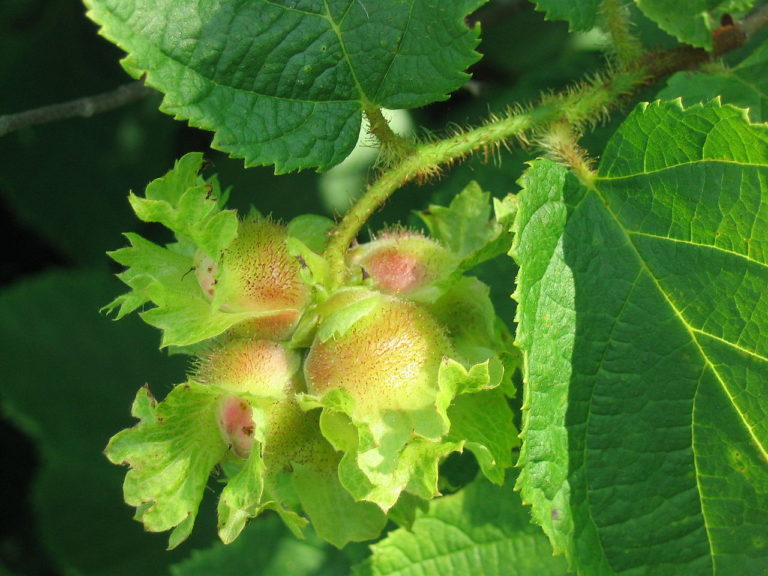American Hazelnut is a medium-sized, deciduous shrub found in moist to dry-mesic woodlands throughout Eastern North America. It is notably absent in the deep South. In North Carolina it is reported only in piedmont and mountain counties. This shrub is valued for its sweet nuts, which are edible either raw or used in cooking, its fall foliage colors, which range from reds and oranges to purple and yellow, and for its all around excellent wildlife value. It is 12-15 feet tall and 10-12 feet wide, colonial in nature, and recognizable by the nuts encased in a leafy husk. It is sun-loving and will thrive in a wide variety of soils if they are well drained. Although it will grow in partial shade, the nut production and fall foliage display will both suffer some. Densely branched with large, doubly serrated leaves, American Hazelnut provides excellent cover for a variety of small animals and habitat for songbirds. The foliage supports an array of insects and larvae of butterflies and moths as well as browse by deer and rabbits. The nuts are favored by game birds such as Bobwhites and Ruffed Grouse. Being colonial, it is best used as a hedge or screen or in a natural area where this trait serves as an asset rather than a maintenance item.
NURSERY HOURS
Wednesday: 10-4 Thursday: 10-6 Friday-Saturday: 10-4 Sunday: 12-4
Corylus americana

Key Info
Scientific Name: Corylus americana Walter
Common Names: American Hazelnut, American Filbert
Family Names: Betulaceae (Birch Family)
Plant Type: Tree / Shrub
Leaf Retention: Deciduous
Flower Color: Yellow turning brown (male) and inconspicuous, red (female)
Special Characteristics: Showy fruit, Good for hedges, Attracts birds, Long lived, Edible fruit (in jams), Good wildlife cover, Rhizomatous
Additional Info
Habit: Rounded, multi-stemmed, densely branched shrub, suckers from roots to form thickets, roots shallow, woody and highly branched
Height: 8' to 15'
Spread: 8'-12'
Soil Conditions: Broad range of soil pH and texture, rocky, sandy loamy --but well drained
Leaves: Simple, oval, doubly serrated, about 6 inches long by 4 inches wide, glabrous medium green above, pubescent below mild yellow in fall.
Flowers (or reproductive structures: Monoecious; showy yellow male catkins form in fall, overwinter, and in spring elongate to about 6"; small, inconspicious, reddish female catkins in spring.
Fruit: Small egg-shaped, edible nuts are encased in leafy bracts, ripening in July/August.
Natural Distribution: Rocky, upland woodlands, wood margins, pastures, dry thickets.
USDA Hardiness Zone: 4 to 9
USDA Wetland Indicator Status in NC: FACU
Pollination: Wind
Wildlife Connections: Excellent habitat for songbirds; the nuts are consumed by game birds such as Bobwhites, Wild Turkeys Ruffed Grouse, pheasants; the low, dense branching and large leaves make excellent cover for all kinds of animals; many insects and larvae of butterflies and moths feed on the leaves (Illinoiswildflowers.info).
Propagation: By seed or softwood cuttings (cuttings have low survival).
